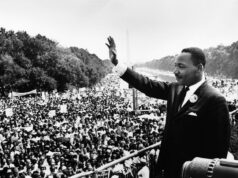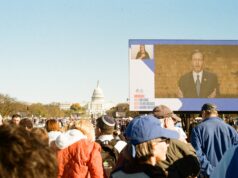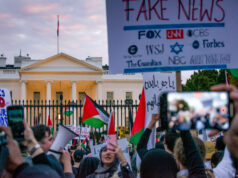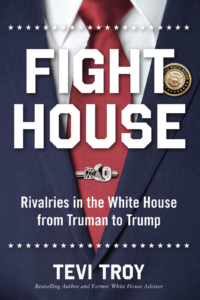 I admit it. I read Appendix II first, and I’m pretty sure you will too.
I admit it. I read Appendix II first, and I’m pretty sure you will too.
When the book is subtitled “Rivalries in the White House from Truman to Trump” and the Appendix is called “White House Nicknames,” you have to go there. You will be rewarded. Hamas, Yoda, Keyser Soze, Nurse Ratched, Fat Kraut, and GK (for Grassy Knoll) all make an appearance. Cousin Cheap, the Garbage Man, Huckleberry Capone, and Meatball Mind, too.
But so much for cheap laughs.
Fight House, by presidential historian, analyst and bestselling author Tevi Troy, is a serious – OK, mostly serious – consideration of how presidents have managed their staffs and staff rivalries since the Roosevelt administration.
Troy has extensive White House experience, having served in several high-level positions, culminating in a stint as Deputy Assistant and then Acting Assistant to the President for Domestic Policy. Experience is good, but what Troy really brings to the table is a readable perspective on the presidency. With a Ph.D. in American Civilization, his 2013 book What Jefferson Read, Ike Watched and Obama Tweeted: 200 Years of Popular Culture in the White House was a hit – but President Trump’s use of twitter may require a sequel. Shall We Wake the President was reviewed in inFOCUS in 2016, and received a new round of publicity in the current pandemic – what would Woodrow Wilson have done? Lincoln? George W? Wouldn’t you like to know? Troy is an author who gets inside his subjects and makes them accessible to those of us who don’t and won’t have access.
It is safe to say that no one today has an adult recollection of the period before World War II, the last time in which the federal government was small and limited largely to its constitutional duties. FDR, helped along by the Great Depression, had visions of government as an enormous and powerful force. His vision has been realized in the growth of the Civil Service from 699,000 people in 1940 to 1.8 million in 1960 and the extraordinary growth in spending, aided by the 1913 income tax and augmented by payroll taxes beginning in 1935.
Growth in the White House staff, with its concomitant growth in the (self?) importance of that staff, began incrementally – as growth in Washington always does. In 1936, the Brownlow Committee on Administrative Management was established to help FDR deal with the growing administrative needs engendered by the New Deal. In 1937, the committee concluded, “the President needs help,” suggesting six – just six – executive assistants who would “remain in the background, issue no orders, make no decisions (and) emit no public statements.” They would be, according to the committee, “possessed of high competence” and a “passion for anonymity.”
Anyone who knows anything about government knows that when the idealistic picture met the reality of Washington egos, presidential and otherwise, it was doomed. The While House staff has grown exponentially since the 1930s and acquired more prestige, more responsibility, and ever more ego. This makes the nature of the President and his (so far, only his) willingness to tolerate or even foster dissent and argument within the White House staff and between the staff and the cabinet secretaries a determinant of the success of his policies.
Some Presidents, starting with FDR, encouraged a variety of voices. But Harry Truman, upon arriving in the Oval Office, was horrified by the lack of collegiality among staff members. He forbade infighting. Troy cites historian Alonzo Hamby, “However forced the cordiality may have been between some persons, they all maintained it in their dealings with each other – or found themselves leaving.” At least if they did it in front of Truman.
Clifford, Marshall, and Israel
Truman did stoke one rivalry – that between Clark Clifford and Secretary of State George Marshall. In advance of the declaration of the independence of Israel in 1948, Truman faced pressure on both sides of the recognition issue. He called on Clifford to present the arguments in favor of recognition, Marshall the arguments against. Israel won. Marshall was beyond a sore loser, saying “’If the president were to follow Mr. Clifford’s advice and if in the elections I were to vote, I would vote against the president.’ As Clifford recalled, Marshall’s disloyalty to the president ‘was so shocking that it just kind of lay there for fifteen or twenty seconds and nobody moved.’” Clifford later wrote about Marshall, “Not only did he never speak to me again after that meeting, but, according to his official biographer, he never again mentioned my name.”
But Truman revered Marshall and so he stayed.
It was during the Truman administration that the line between cabinet officials and White House staff began to blur – proximity to the President having a lot to do with that.
Eisenhower liked military structure and delegating authority to the cabinet. He was the first president with a Chief of Staff and the first with a National Security Advisor. While he prized amicability, the feud between Secretary of State John Foster Dulles and Special Assistant to the President for Disarmament Harold Stassen was a classic case of a cabinet secretary seeing a White House staff member as an impediment to his own rise.
The Roaring Sixties
What readers may remember as Camelot in 1960 was actually the beginning of serious change in Washington – the Civil Service had more than doubled since 1940. And Kennedy was a sweeping change from both the Truman and Eisenhower management styles, encouraging differences in some areas, and deliberately bringing in staff that did NOT have that “passion for anonymity” that the Brownlow Committee recommended. Feuding was inevitable. Robert F. Kennedy vs. Lyndon Johnson is legendary. Personal – New England royalty vs. Texas cowboy – and political – New England liberal vs. Texas (relative) conservative – it lasted into the Johnson administration. On the other hand, Kennedy’s “Irish Mafia” and the “Intellectuals,” contrary to expectation, did not feud. Harvard historian Arthur Schlesinger, Jr. and Theodore Sorenson, however, did – and each wrote a book in 1965 about their experiences.
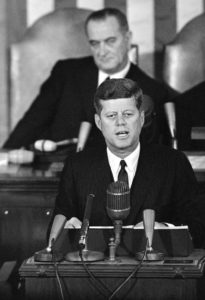
The descriptions of Lyndon Johnson could easily be mistaken for those of Donald Trump and Johnson’s use of the telephone foreshadows Trump’s twitter. Both are described as prodigious workers and hard drivers, and both exhibited a need to have others in company. According to historian Doris Kearns Godwin. “Johnson commanded, forbade, insisted, swaggered, and swore.” Johnson’s Attorney General Nicholas Katzenbach wrote, “[Johnson] occasionally acted in an almost childish manner when news he had been planning to announce leaked out.”
Leaking is a subject unto itself and it leaks across the chapters. The point was always to enhance one’s own reputation and to make one’s nemesis look bad. But for decades it was, relatively, a gentleman’s game; now it is murder – Rowland Evans and Robert Novak, the most-read columnists in town, were part of Washington society, not assassins. The transformation in the book, as in Washington, is alarming; Troy makes it scary/fascinating.
Reagan and Beyond
There is a recurring issue with family as well. Nancy Reagan wasn’t staff, as Bobby Kennedy was, but her clear authority in the White House was another example of what happens when family has to be accounted for. Maneuvering around family, or with family around others, is a whole subset of politics. JFK not only couldn’t ignore Bobby – he made him a cabinet secretary. Reagan not only couldn’t ignore his wife – he didn’t want to. Jimmy Carter took Roselyn very seriously. Bill and Hillary.
Somewhere in the Reagan administration, and certainly in the succeeding administrations, the book becomes more personal. Readers will remember those better than FDR, HST, Ike, et. al. And when you remember them, you also remember the personalities. You remember who you liked and why or disliked and why.
James Baker was a master leaker. Novak, wrote, “Nobody in my long experience was more skillful in manipulating reporters than Baker, who devoted the equivalent of one full working day each week to massaging the important news media.” “Massaging” means leaking. Michael Deaver was trusted by both Ronald and Nancy Reagan, an unassailable position – even Baker worked to be on his buddy list – and they were both determined to get rid of Secretary of State Al Haig, further cementing their relationship. Ed Meese and Donald Regan, David Gergen, Peggy Noonan, Larry Speakes, and David Stockman all edged around, looking for advantage.
Reagan himself is described as “amiable and agreeable… but he also had well-formed ideological principles and knew what he wanted.” Loath to involve himself in staff arguments, he deflected them, often suggesting. “Okay, you fellas work it out.” Sometimes they did; sometimes they didn’t.
The George H.W. Bush administration was described as “the third Reagan term,” and Bill Clinton’s as “semi-controlled chaos.” The impeachment trial was a motivating factor in the second Clinton term, subsuming political disagreements in an effort to prevent the unraveling of the administration. Troy notes, “Political crises can themselves serve as a potent way to resolve the nagging problem of internal White House dissention.” George W. Bush had an ideologically cohesive staff and, as time went on, the domestic side ran smoothly. While there was an unheard of level of acceptance by the American public of Bush’s response to the attacks of 9-11, the administration’s Iraq policy brought people with decades of experience in Washington nearly to blows: Donald Rumsfeld, Dick Cheney, Colin Powell, and others leaked and fought, fought and leaked.
“No Drama Obama” had a rift over the lack of senior female staff in the White House, a Valerie Jarrett-vs-everyone rift, and a generational divide that pitted Ben Rhodes against more senior people, plus the profanity of Rahm Emanuel. The administration was, however, in comparison to others, largely quiet and ideologically cohesive. Revelations in 2020 over the misuse of intelligence, FISA warrants, surveillance, leaks, and other dodges to negatively affect the Trump administration might have, as happened in the Clinton administration, kept staffers pulling in the same direction – the final fallout remains to be seen.
President Trump appears only in the conclusion, the timing of publication making a more in-depth consideration impossible. However, it is a very good idea to read Fight House to remind yourself that every modern White House has seen backbiting, self-promoting, ego, leaking even some out and out fabrications. Until recently, however, outsiders looking in simply didn’t have social media and an ideological press to magnify the disagreements.
Fight House gives us an essential piece of Washington history and some pretty good laughs.
Shoshana Bryen is the editor of inFOCUS Quarterly and Senior Director of the Jewish Policy Center.


